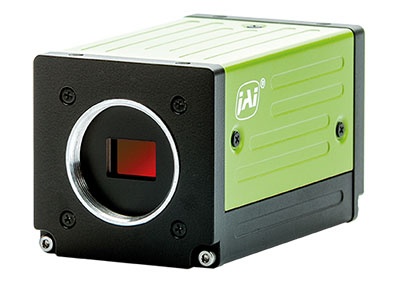
JAI has introduced a total of 5 new Apex Series 3-CMOS prism-based area scan cameras to join with the original AP-3200T-USB 3-CMOS camera introduced in late 2017. The resulting suite of advanced three-sensor color area scan cameras gives system designers a choice of:
- Two resolutions – 3 x 3.2 megapixels (AP-3200T) and 3 x 1.6 megapixels (AP-1600T)
- Three interfaces – PMCL, USB3 Vision, and GigE Vision
- Frame rates as fast as 126 fps (for 1.6-megapixels over Camera Link
![]()
The new Apex AP-3200T and
AP-1600T models will be
displayed at Vision 2018
This full range of features and functions are making it easier than ever before for machine vision designers to consider the advantages of 3-sensor prism technology for their next generation of color inspection systems.
The specific new models announced include two new 3.2-megapixel models:
- AP-3200T-PGE providing 3.2 megapixels at 12 fps over GigE Vision
- AP-3200T-PMCL providing 3.2 megapixels at 55 fps over Camera Link
Like the original AP-3200T-USB, these models feature the Sony PregiusTM IMX265 1/1.8" CMOS imager with 3.45 micron pixels at a resolution of 2048 x 1544.
In addition, three new 1.6-megapixel models have been added:
- AP-1600T-PGE providing 1.6 megapixels at 24 fps over GigE Vision
- AP-1600T-USB providing 1.6 megapixels at 78 fps over USB3 Vision
- AP-1600T-PMCL providing 1.6 megapixels at 126 fps over Camera Link
These models feature the Sony PregiusTM IMX273 1/2.9" CMOS imager with 3.45 micron pixels at a resolution of 1456 x 1088.![]()
In nature, no one handles color better than the chameleon. And for color vision systems, no industrial cameras handle color better than the Apex Series. With their new 3-CMOS, prism-based technology, these Apex cameras provide significantly higher color accuracy and spatial precision than typical Bayer-filter cameras.
All of the new Apex Series cameras are loaded with a range of advanced feature sets supporting the most challenging color imaging applications. The color space conversion tool provides great flexibility in on-board color space conversion: including RGB to HSI color space conversion and RGB to CIE-XYZ color space conversion. (sRGB and Adobe RGB color spaces are also supported).
The gain (both analog and digital) and the exposure time can be set independently for the red, green and blue sensor channels allowing for better signal/noise conditions. This maximizes the dynamic range for each color channel resulting in improved image quality.
With the color enhancer tool it is possible to strengthen certain colors in the image (double emphasis) for additive hues (red, green and blue) and subtractive hues (cyan, magenta and yellow). This feature is particularly useful in certain applications such as microscopy and medical imaging.
Other features include multi-ROI support, edge enhancement, ALC (integrated auto gain and auto shutter), color pixel binning and chunk data.
The new cameras utilize a new prism design making it more than 50 percent smaller and nearly 50 percent lighter than JAI’s previous 3CCD models, despite having much higher resolution. The camera is robustly built with a 50G shock rating and 3G vibration rating which, combined with an operating temperature range of -5°C to +45°C (ambient), enables the cameras to operate reliably in a wide range of industrial environments.
Applications include:
- Print inspection including packaging and labels.
- Microscopy
- Eye diagnostics
- Digital pathology
- Surgical imaging
- Inspection of medical devices
- Color verification of pharmaceutical items
- Automotive inspection including paint matching, LEDs, and instrumentation
- Certain types of meat or other food inspection
- Wafer inspection
- Inspection of colored parts on printed circuit boards
- Color calibration on LED screens
- Mining and mineralogy, sorting ores and gemstones based on subtle color differences.
